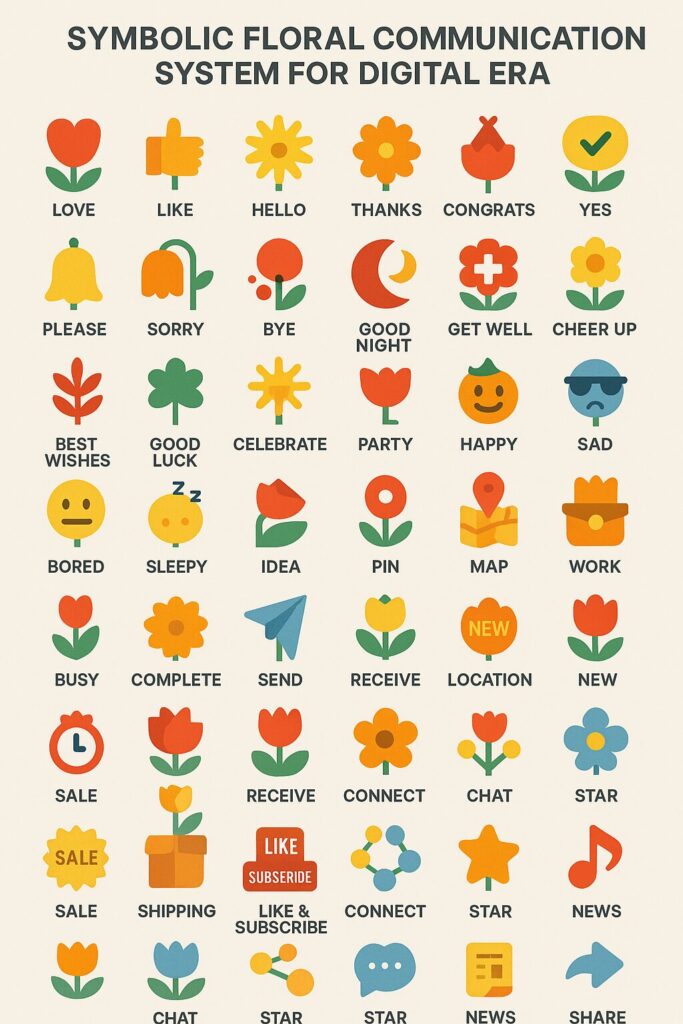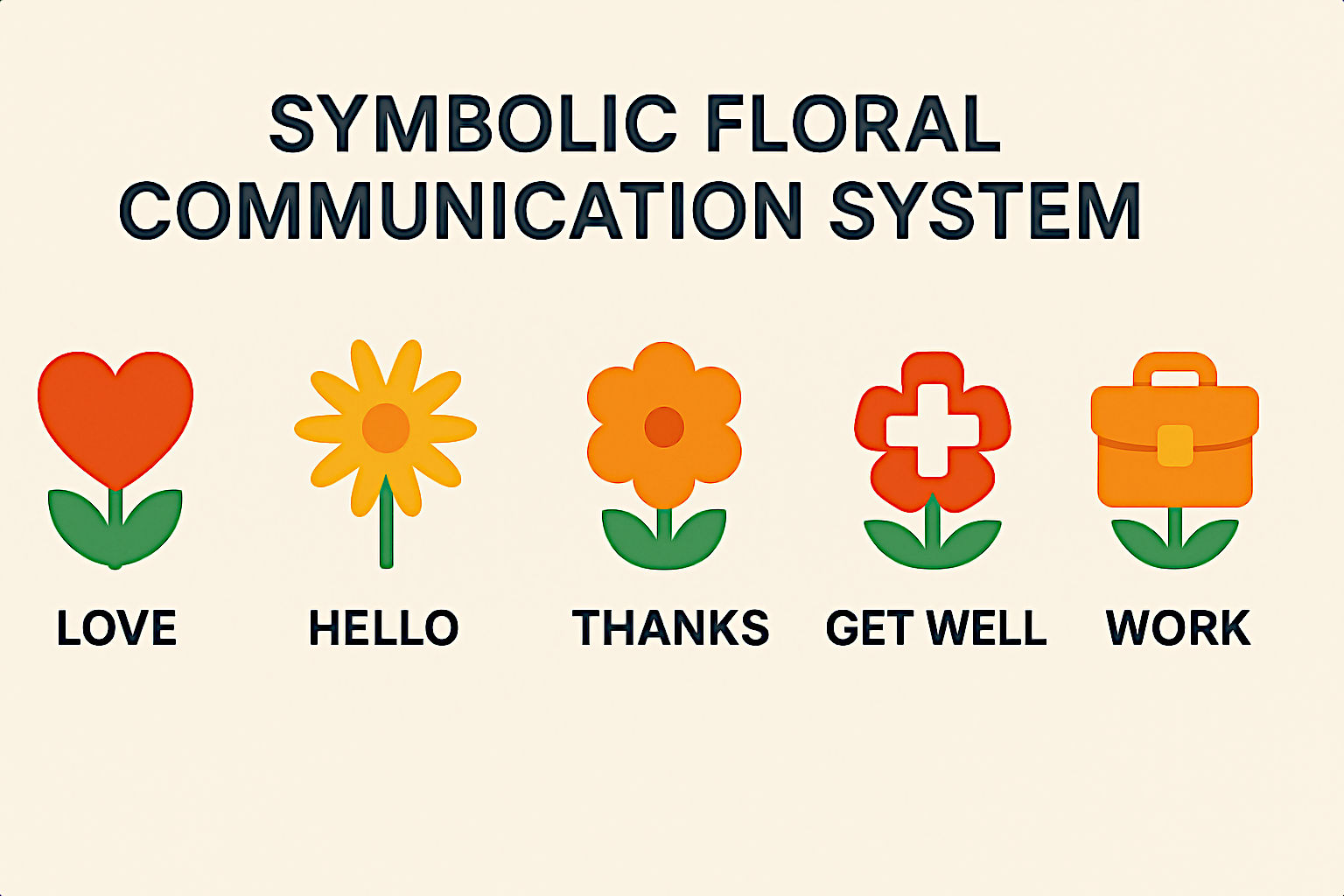Digital communication has gone far beyond basic emoticons and standard emojis. A groundbreaking symbolic floral communication system is emerging that bridges the gap between Victorian flower language and modern digital expression. Now entrepreneurs in the floral AI space have a sophisticated framework for meaningful customer experiences.
The Victorian Foundation Meets Digital Innovation
The traditional Victorian language of flowers (floriography) gave specific meanings to different blooms – red roses for passionate love, yellow roses for friendship, forget-me-nots for remembrance. This new digital system expands that concept by creating floral symbols that represent modern communication needs: from basic greetings to complex business interactions.
The system sorts symbols into practical communication cohorts: emotional expressions, social interactions, business communications, and even digital actions. Each symbol keeps the aesthetic appeal of floral imagery while serving functional purposes in our screen-dominated world.

Core Communication Categories
Emotional Expression Symbols form the foundation of this system. The heart-tulip represents “LOVE,” while the thumbs-up daisy indicates “LIKE.” More delicate emotions get their own floral representations: the drooping blue flower with sunglasses communicates “SAD,” the sleeping yellow bloom with “Zz” conveys “SLEEPY,” and the neutral-faced yellow flower expresses “BORED.” These symbols provide emotional nuances that standard emoji sets often lack.
Social Interaction Symbols address everyday digital courtesies(netiquette). The bright yellow sunburst flower means “HELLO,” while the orange daisy represents “THANKS.” The “SORRY” symbol uses a drooping orange tulip with green accent, visually saying regret through its downward orientation. Celebratory occasions get their own symbols: the four-leaf clover for “GOOD LUCK,” the party tulip for celebration, and the congratulatory rose with an X mark.
Business and Professional Symbols represent perhaps the most innovative aspect of this system. The briefcase flower symbolizes “WORK,” while the map icon flower indicates “LOCATION.” The “SEND” symbol uses a paper airplane design integrated with floral elements, and “RECEIVE” features an upward-facing yellow bloom. The clock-tulip represents time-sensitive communications like “SALE” notifications.
Practical Implementation Advantages
This floral symbol system offers many advantages over traditional digital communication methods. First, the aesthetic consistency creates a cohesive visual language that’s immediately recognizable across platforms. Unlike emoji sets that vary between operating systems, these standardized floral symbols maintain their meaning and appearance universally.
Second, the system addresses cultural sensitivity issues. While traditional flowers carry different meanings across cultures, these simplified, symbolic representations focus on universal human experiences rather than culture-specific flower meanings. The “THANKS” daisy works equally well for users in Tokyo, London, or São Paulo.
Third, the professional applicability sets this system apart from casual emoji use. The business-oriented symbols like “SHIPPING,” “CONNECT,” and “SUBSCRIBE” enable formal communications while maintaining visual appeal. A florist could use the shipping box flower to indicate order status, or the star flower to highlight premium services.
AI Integration Opportunities
For floral AI entrepreneurs, this system presents multiple monetization pathways. Automated customer service bots could use these symbols to create more engaging, visually appealing transactions. Instead of text-based order confirmations, customers receive the “COMPLETE” flower symbol alongside traditional notifications.
Sentiment analysis AI could interpret customer communications and respond with appropriate floral symbols, creating more emotionally charged interactions. A customer expressing frustration might receive the “SORRY” drooping tulip, while positive feedback triggers the “THANKS” daisy response.
Predictive analytics could suggest appropriate floral symbols based on customer behavior patterns, seasonal trends, or purchase history. Valentine’s Day approaches might trigger increased use of the “LOVE” heart-tulip in marketing communications.
Market Research and Adoption Patterns
Early adoption studies indicate highest engagement rates with emotionally expressive symbols, particularly “HAPPY,” “CELEBRATE,” and “GET WELL” variants. Business symbols show strong performance in B2B communications, with “WORK,” “CONNECT,” and “COMPLETE” seeing regular usage in professional contexts.
The versatility of combination usage – where multiple symbols create complex messages – opens opportunities for advanced AI interpretation systems. A “MAP” + “STAR” + “NEW” combination could indicate a new premium location, while “SALE” + “SHIPPING” + “YES” might confirm a promotional order.
Implementation Considerations
Successful use requires careful attention to recognizing symbols across different screen sizes and resolutions. The simplified design approach ensures clarity on both desktop displays and mobile screens, but further testing across various devices is important.
Adapting to existing communication platforms will require API development that maintains symbol integrity, while also ensuring fast loading times. The visual appeal that makes these symbols effective could become a liability if load times suffer.
Future Applications in Floral AI
Consider developing AI systems that automatically generate appropriate floral symbol combinations based on customer journey stages, seasonal flower availability, or even local weather patterns that may affect delivery schedules. Could your AI predict when customers need the “CHEER UP” flower before they even express disappointment? What about systems that use floral symbols to gamify the ordering experience by rewarding frequent customers with exclusive symbol access?
The intersection of symbolic communication and AI-driven personalization represents untapped potential for creating deeper, more meaningful customer relationships in the digital floral marketplace.
